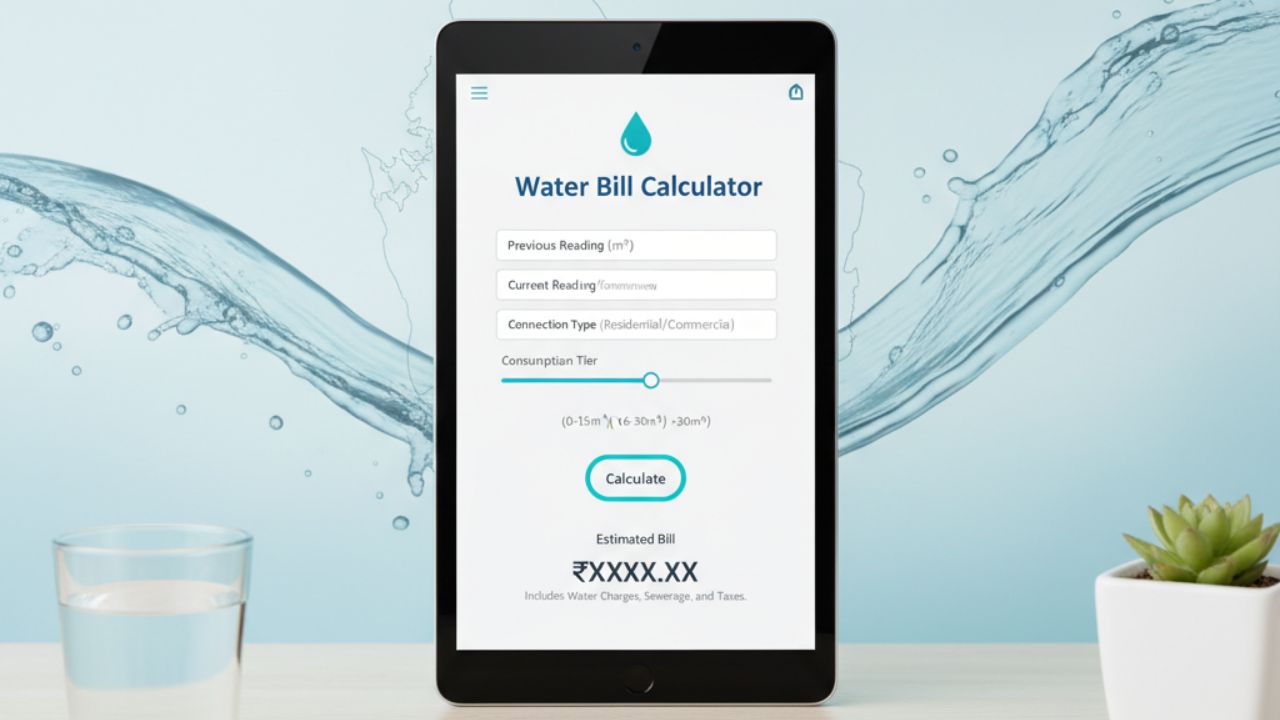KWA Water Bill Calculator
Estimate your Kerala Water Authority water charges quickly and accurately with our easy-to-use calculator
Calculate Your Water Bill
Estimated Water Bill
₹ 0.00
This is an estimate. Your actual bill may vary based on additional charges and taxes.
Frequently Asked Questions
The KWA water bill is calculated based on your water consumption measured in kiloliters (KL). The billing follows a slab system where different rates apply to different consumption ranges. Additional fixed charges, meter charges, and sanitation cess are also added to the final bill amount.
For domestic connections, KWA typically follows these tariff slabs (rates may vary):
- First 10 KL: ₹ 8 per KL
- Next 10 KL (11-20 KL): ₹ 12 per KL
- Next 10 KL (21-30 KL): ₹ 16 per KL
- Above 30 KL: ₹ 20 per KL
There’s also a minimum charge that applies even if consumption is zero.
KWA typically generates water bills on a bimonthly basis. This means you receive a bill every two months. However, in some areas or for specific connection types, billing might be done monthly. The billing cycle is usually mentioned on your water bill.
If you believe your KWA water bill is incorrect, you should:
- Verify your current meter reading and compare it with the billed reading
- Check for any leaks in your plumbing system
- Contact your local KWA office with your consumer number
- Request for a meter testing if you suspect meter malfunction
- Submit a written complaint with supporting documents if necessary
Yes, KWA offers concessions for senior citizens. Eligible senior citizens (usually above 60 or 65 years, depending on the specific scheme) can avail a rebate on their water charges. To apply for this concession, you need to submit an application along with age proof at your local KWA office. The concession percentage and eligibility criteria may vary, so it’s best to check with your local KWA office for the most current information.
Understanding Your KWA Water Bill: A Comprehensive Guide
Water is an essential resource, and managing its consumption and costs is crucial for every household and business in Kerala. The Kerala Water Authority (KWA) is responsible for providing clean drinking water across the state, and understanding how your water bill is calculated can help you manage your expenses better and potentially reduce your water consumption.
How KWA Water Billing Works
The KWA uses a metered billing system where your water consumption is measured through a water meter installed at your property. These meters record consumption in cubic meters (m³), which is equivalent to kiloliters (KL). One kiloliter equals 1,000 liters of water.
Your water bill typically consists of several components:
- Water Charges: Based on your actual consumption measured in KL
- Fixed Charges: A minimum charge that applies regardless of consumption
- Meter Charges: Based on the size of your water meter
- Sanitation Cess: A charge for sewerage services if applicable
- Other Taxes and Surcharges: As per government regulations
Understanding Tariff Slabs
KWA follows an increasing block tariff system, which means the per-unit cost of water increases as your consumption increases. This system is designed to promote water conservation while ensuring basic water needs are affordable for all.
Domestic vs. Commercial Tariffs
KWA has different tariff structures for domestic and non-domestic (commercial/industrial) connections. Domestic tariffs are generally lower to ensure affordability for households, while commercial and industrial tariffs are higher.
For domestic connections, the tariff slabs are designed to provide essential water at lower rates, with higher rates applying to excessive consumption. This progressive pricing encourages water conservation while ensuring that basic needs are met affordably.
Commercial establishments, on the other hand, pay higher rates across all consumption slabs. Industrial units may have different tariff structures based on their specific water requirements and consumption patterns.
Reading Your Water Meter
Understanding how to read your water meter can help you track your consumption and verify your bills. Most KWA meters have a digital or analog display showing cubic meters consumed. The black numbers represent whole cubic meters, while the red numbers represent fractions (liters).
To monitor your consumption:
- Record the meter reading at the beginning and end of a specific period
- Subtract the initial reading from the final reading to get consumption
- Compare this with your billed consumption
Tips to Reduce Your Water Bill
Reducing your water consumption not only lowers your bill but also contributes to water conservation efforts. Here are some practical tips:
- Fix Leaks Promptly: A dripping tap can waste up to 20 liters of water per day
- Install Water-Efficient Fixtures: Low-flow showerheads and faucet aerators can reduce water use by 30-50%
- Practice Smart Gardening: Water plants during cooler parts of the day to reduce evaporation
- Collect Rainwater: Use rainwater for gardening and cleaning purposes
- Full Loads Only: Run washing machines and dishwashers only with full loads
- Shorter Showers: Reducing shower time by just 2 minutes can save up to 30 liters
Dispute Resolution and Customer Service
If you have concerns about your water bill, KWA has established procedures for dispute resolution. The first step is to contact your local KWA office with your consumer number and the bill in question. If the issue isn’t resolved at the local level, you can escalate it to higher authorities within KWA.
KWA also offers various customer service channels, including online bill payment, complaint registration through their website, and helpline numbers for immediate assistance.
Understanding your KWA water bill is the first step toward effective water management and conservation. By being aware of how charges are calculated and monitoring your consumption, you can not only control your expenses but also contribute to the sustainable use of this precious resource. Use the calculator above to estimate your bills and implement water-saving practices to make a positive impact on both your wallet and the environment.
